Comparison of Business Analytics Tools
VerifiedAdded on 2023/03/31
|8
|1883
|252
AI Summary
This article provides a comparison of major business analytics tools including QlikView, Klipfolio, Tableau, Geckoboard, Power BI, and Google Data Studio. It discusses their features, usability, pricing, and product differentiators. The article aims to help businesses select the best tool based on their specific requirements.
Contribute Materials
Your contribution can guide someone’s learning journey. Share your
documents today.
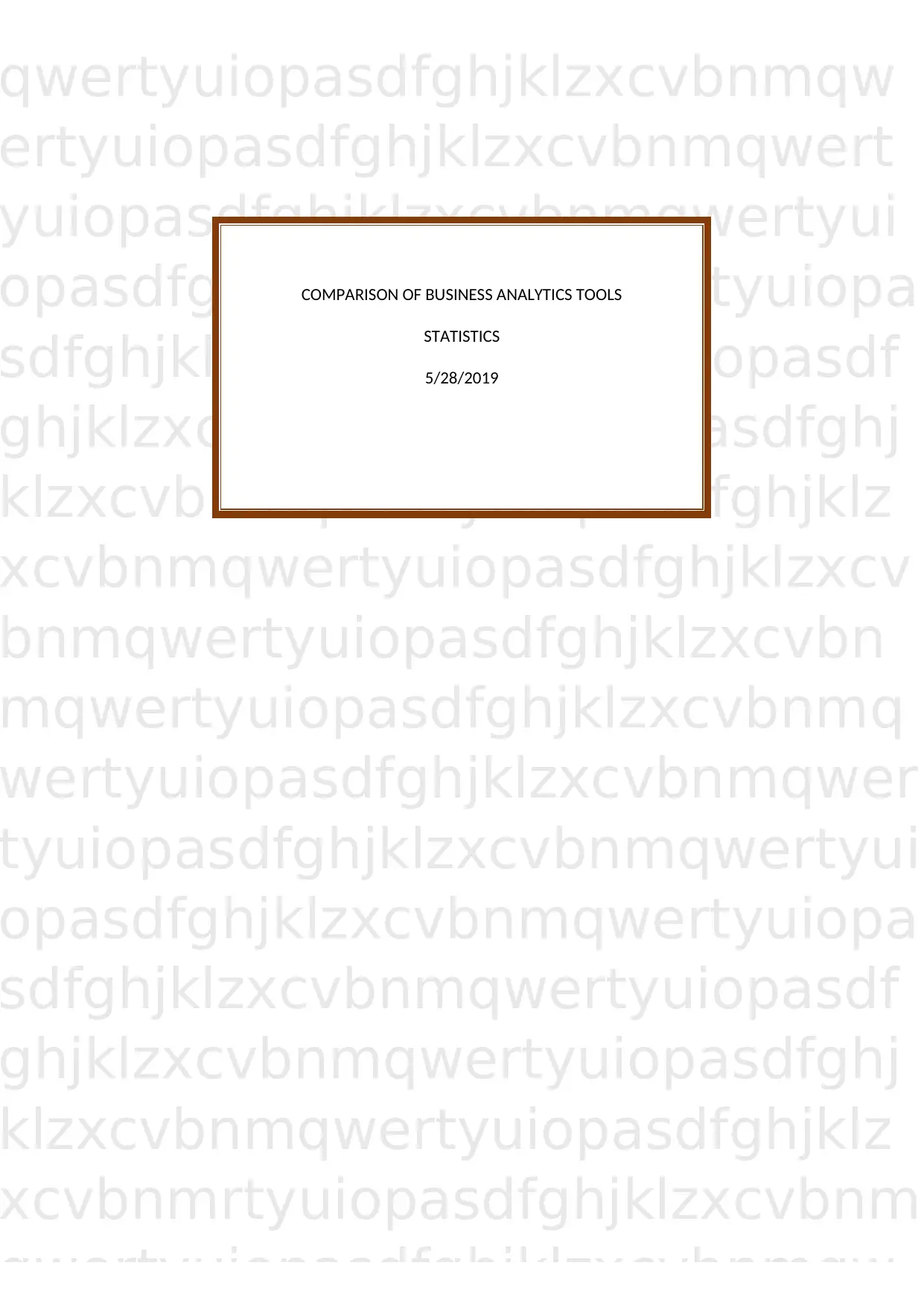
qwertyuiopasdfghjklzxcvbnmqw
ertyuiopasdfghjklzxcvbnmqwert
yuiopasdfghjklzxcvbnmqwertyui
opasdfghjklzxcvbnmqwertyuiopa
sdfghjklzxcvbnmqwertyuiopasdf
ghjklzxcvbnmqwertyuiopasdfghj
klzxcvbnmqwertyuiopasdfghjklz
xcvbnmqwertyuiopasdfghjklzxcv
bnmqwertyuiopasdfghjklzxcvbn
mqwertyuiopasdfghjklzxcvbnmq
wertyuiopasdfghjklzxcvbnmqwer
tyuiopasdfghjklzxcvbnmqwertyui
opasdfghjklzxcvbnmqwertyuiopa
sdfghjklzxcvbnmqwertyuiopasdf
ghjklzxcvbnmqwertyuiopasdfghj
klzxcvbnmqwertyuiopasdfghjklz
xcvbnmrtyuiopasdfghjklzxcvbnm
qwertyuiopasdfghjklzxcvbnmqw
COMPARISON OF BUSINESS ANALYTICS TOOLS
STATISTICS
5/28/2019
ertyuiopasdfghjklzxcvbnmqwert
yuiopasdfghjklzxcvbnmqwertyui
opasdfghjklzxcvbnmqwertyuiopa
sdfghjklzxcvbnmqwertyuiopasdf
ghjklzxcvbnmqwertyuiopasdfghj
klzxcvbnmqwertyuiopasdfghjklz
xcvbnmqwertyuiopasdfghjklzxcv
bnmqwertyuiopasdfghjklzxcvbn
mqwertyuiopasdfghjklzxcvbnmq
wertyuiopasdfghjklzxcvbnmqwer
tyuiopasdfghjklzxcvbnmqwertyui
opasdfghjklzxcvbnmqwertyuiopa
sdfghjklzxcvbnmqwertyuiopasdf
ghjklzxcvbnmqwertyuiopasdfghj
klzxcvbnmqwertyuiopasdfghjklz
xcvbnmrtyuiopasdfghjklzxcvbnm
qwertyuiopasdfghjklzxcvbnmqw
COMPARISON OF BUSINESS ANALYTICS TOOLS
STATISTICS
5/28/2019
Secure Best Marks with AI Grader
Need help grading? Try our AI Grader for instant feedback on your assignments.

Contents
BUSINESS INTELLIGENCE.........................................................................................................................
BI TOOLS..................................................................................................................................................
Major BI Tools......................................................................................................................................
QlikView...........................................................................................................................................
Klipfolio............................................................................................................................................
Tableau............................................................................................................................................
Geckoboard.....................................................................................................................................
Power BI..........................................................................................................................................
Google Data Studio..........................................................................................................................
CONCLUSION...........................................................................................................................................
REFERENCES............................................................................................................................................
BUSINESS INTELLIGENCE
Business Intelligence is a combination fo technologies and strategies for business information
data analytics used by enterprises. Business intelligence has the common functions that
include text mining, data mining, complex event processing, online analytical processing,
business performance management, prescriptive analytics, benchmarking, predictive
analytics, process mining and analytics [1].
BI TOOLS
There are numerous business tools, which solve business problems, deliver promising results
and deliver several business benefits. So, by seeing the company and software it is difficult to
compare and select the best out of them. Hence, the better way is to consider the reviews of
the BI tool users [2]. BI collects feedback from the users more than 3000 and so far collected
for 18 years, comparing 37 prominent business intelligence tools.
Major BI Tools
QlikView
QlikView has the features that help to explore and discover the business data, right in the
workflow, just how developers do work, while data processing. This tool can maintain the
association among variety of data to provide flexibility in the data visualization and
exploration approaches. This feature facilitates the data discovery by the end-user, who seeks
a specific data piece being aware of any relevant item retrieval, in any circumstances, though
the search items origins applicable are disjoint incredibly. It needs the ability to integrate the
queries and apply programmatic interface.
BUSINESS INTELLIGENCE.........................................................................................................................
BI TOOLS..................................................................................................................................................
Major BI Tools......................................................................................................................................
QlikView...........................................................................................................................................
Klipfolio............................................................................................................................................
Tableau............................................................................................................................................
Geckoboard.....................................................................................................................................
Power BI..........................................................................................................................................
Google Data Studio..........................................................................................................................
CONCLUSION...........................................................................................................................................
REFERENCES............................................................................................................................................
BUSINESS INTELLIGENCE
Business Intelligence is a combination fo technologies and strategies for business information
data analytics used by enterprises. Business intelligence has the common functions that
include text mining, data mining, complex event processing, online analytical processing,
business performance management, prescriptive analytics, benchmarking, predictive
analytics, process mining and analytics [1].
BI TOOLS
There are numerous business tools, which solve business problems, deliver promising results
and deliver several business benefits. So, by seeing the company and software it is difficult to
compare and select the best out of them. Hence, the better way is to consider the reviews of
the BI tool users [2]. BI collects feedback from the users more than 3000 and so far collected
for 18 years, comparing 37 prominent business intelligence tools.
Major BI Tools
QlikView
QlikView has the features that help to explore and discover the business data, right in the
workflow, just how developers do work, while data processing. This tool can maintain the
association among variety of data to provide flexibility in the data visualization and
exploration approaches. This feature facilitates the data discovery by the end-user, who seeks
a specific data piece being aware of any relevant item retrieval, in any circumstances, though
the search items origins applicable are disjoint incredibly. It needs the ability to integrate the
queries and apply programmatic interface.
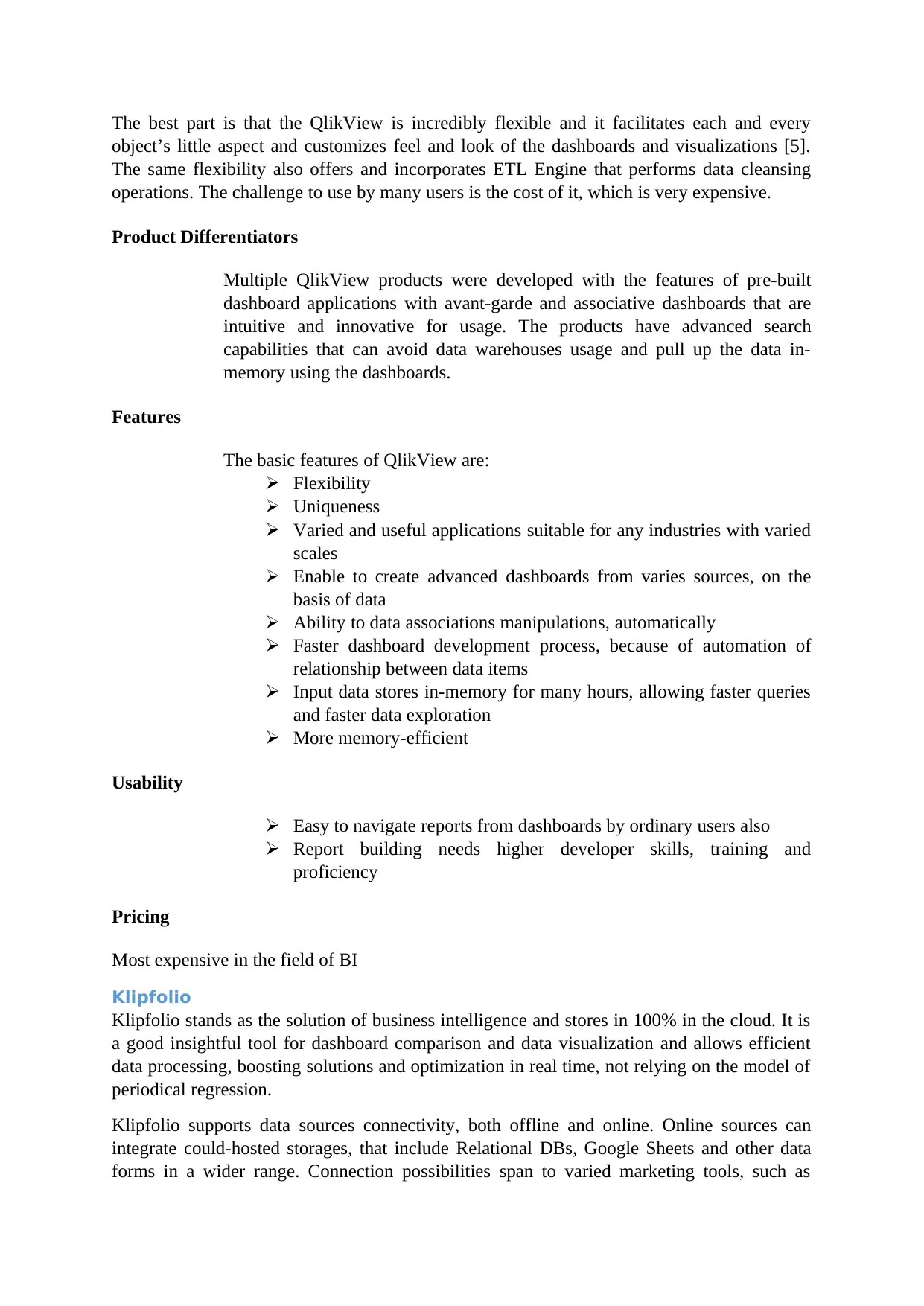
The best part is that the QlikView is incredibly flexible and it facilitates each and every
object’s little aspect and customizes feel and look of the dashboards and visualizations [5].
The same flexibility also offers and incorporates ETL Engine that performs data cleansing
operations. The challenge to use by many users is the cost of it, which is very expensive.
Product Differentiators
Multiple QlikView products were developed with the features of pre-built
dashboard applications with avant-garde and associative dashboards that are
intuitive and innovative for usage. The products have advanced search
capabilities that can avoid data warehouses usage and pull up the data in-
memory using the dashboards.
Features
The basic features of QlikView are:
Flexibility
Uniqueness
Varied and useful applications suitable for any industries with varied
scales
Enable to create advanced dashboards from varies sources, on the
basis of data
Ability to data associations manipulations, automatically
Faster dashboard development process, because of automation of
relationship between data items
Input data stores in-memory for many hours, allowing faster queries
and faster data exploration
More memory-efficient
Usability
Easy to navigate reports from dashboards by ordinary users also
Report building needs higher developer skills, training and
proficiency
Pricing
Most expensive in the field of BI
Klipfolio
Klipfolio stands as the solution of business intelligence and stores in 100% in the cloud. It is
a good insightful tool for dashboard comparison and data visualization and allows efficient
data processing, boosting solutions and optimization in real time, not relying on the model of
periodical regression.
Klipfolio supports data sources connectivity, both offline and online. Online sources can
integrate could-hosted storages, that include Relational DBs, Google Sheets and other data
forms in a wider range. Connection possibilities span to varied marketing tools, such as
object’s little aspect and customizes feel and look of the dashboards and visualizations [5].
The same flexibility also offers and incorporates ETL Engine that performs data cleansing
operations. The challenge to use by many users is the cost of it, which is very expensive.
Product Differentiators
Multiple QlikView products were developed with the features of pre-built
dashboard applications with avant-garde and associative dashboards that are
intuitive and innovative for usage. The products have advanced search
capabilities that can avoid data warehouses usage and pull up the data in-
memory using the dashboards.
Features
The basic features of QlikView are:
Flexibility
Uniqueness
Varied and useful applications suitable for any industries with varied
scales
Enable to create advanced dashboards from varies sources, on the
basis of data
Ability to data associations manipulations, automatically
Faster dashboard development process, because of automation of
relationship between data items
Input data stores in-memory for many hours, allowing faster queries
and faster data exploration
More memory-efficient
Usability
Easy to navigate reports from dashboards by ordinary users also
Report building needs higher developer skills, training and
proficiency
Pricing
Most expensive in the field of BI
Klipfolio
Klipfolio stands as the solution of business intelligence and stores in 100% in the cloud. It is
a good insightful tool for dashboard comparison and data visualization and allows efficient
data processing, boosting solutions and optimization in real time, not relying on the model of
periodical regression.
Klipfolio supports data sources connectivity, both offline and online. Online sources can
integrate could-hosted storages, that include Relational DBs, Google Sheets and other data
forms in a wider range. Connection possibilities span to varied marketing tools, such as

Radian6 Sales Marketing, Mixpanel, Oracle Sales Cloud from Trello, Twitter and Google
Analytics tools [2013]. Own data source can also be hooked up, by using RESTful API data
source. Klipfolio can support varied services in offline, like JSON, XML, CSV, MS Excel,
etc.
Klipfolio applies responsiveness principles for facilitation of dashboard discovery from
smartphones, tablets and varied platforms of technologies to smart TVs and desktop
computer.
Product Differentiators
Klipfolia builds various products that represent powerful platforms of data dashboards for
lively data sources and real-world access. Products are developed for control over flow of
continuous data, through live monitoring, where urgent decisions are required.
Features
Unlimited connections
Multiple data sources integration in a single report
Management of restrictions and rights of access for significant data
and information
Secure SQL database connection
Mobile accessibility
Threshold indicators that are easy to use
KPI editing platform with self-service
Handy annotations to user reports
Usability
Klipfolio comprises of several visualization types that include bar charts, area and line charts,
pie charts, plain tables and combined charts along with scatter plots. Users of HTML and
CSS can create their unique and own visualizations, additionally. These components can be
laid out using WYSIWYG editor on the composite dashboards. Sophisticated visualization
elements can also be added with different functions and formulas.
Dashboard features offers framework collaboration extensively for information shared with
other, on the basis of permissions and enable distribution and notification through email. All
the computatisn are performed through formulas and functions, using any visualization to
create sheets
Pricing
Klipfolio is not very expensive and customizable payments are allowed.
Tableau
Tableau zeros, on data analytics through means of visualization. The tool has objectives of
interactive data dashboards creation and distribution easily. The dashboards can provide
depiction of data density distributions, trends of change and dynamics through effective
visuals.
Analytics tools [2013]. Own data source can also be hooked up, by using RESTful API data
source. Klipfolio can support varied services in offline, like JSON, XML, CSV, MS Excel,
etc.
Klipfolio applies responsiveness principles for facilitation of dashboard discovery from
smartphones, tablets and varied platforms of technologies to smart TVs and desktop
computer.
Product Differentiators
Klipfolia builds various products that represent powerful platforms of data dashboards for
lively data sources and real-world access. Products are developed for control over flow of
continuous data, through live monitoring, where urgent decisions are required.
Features
Unlimited connections
Multiple data sources integration in a single report
Management of restrictions and rights of access for significant data
and information
Secure SQL database connection
Mobile accessibility
Threshold indicators that are easy to use
KPI editing platform with self-service
Handy annotations to user reports
Usability
Klipfolio comprises of several visualization types that include bar charts, area and line charts,
pie charts, plain tables and combined charts along with scatter plots. Users of HTML and
CSS can create their unique and own visualizations, additionally. These components can be
laid out using WYSIWYG editor on the composite dashboards. Sophisticated visualization
elements can also be added with different functions and formulas.
Dashboard features offers framework collaboration extensively for information shared with
other, on the basis of permissions and enable distribution and notification through email. All
the computatisn are performed through formulas and functions, using any visualization to
create sheets
Pricing
Klipfolio is not very expensive and customizable payments are allowed.
Tableau
Tableau zeros, on data analytics through means of visualization. The tool has objectives of
interactive data dashboards creation and distribution easily. The dashboards can provide
depiction of data density distributions, trends of change and dynamics through effective
visuals.
Secure Best Marks with AI Grader
Need help grading? Try our AI Grader for instant feedback on your assignments.
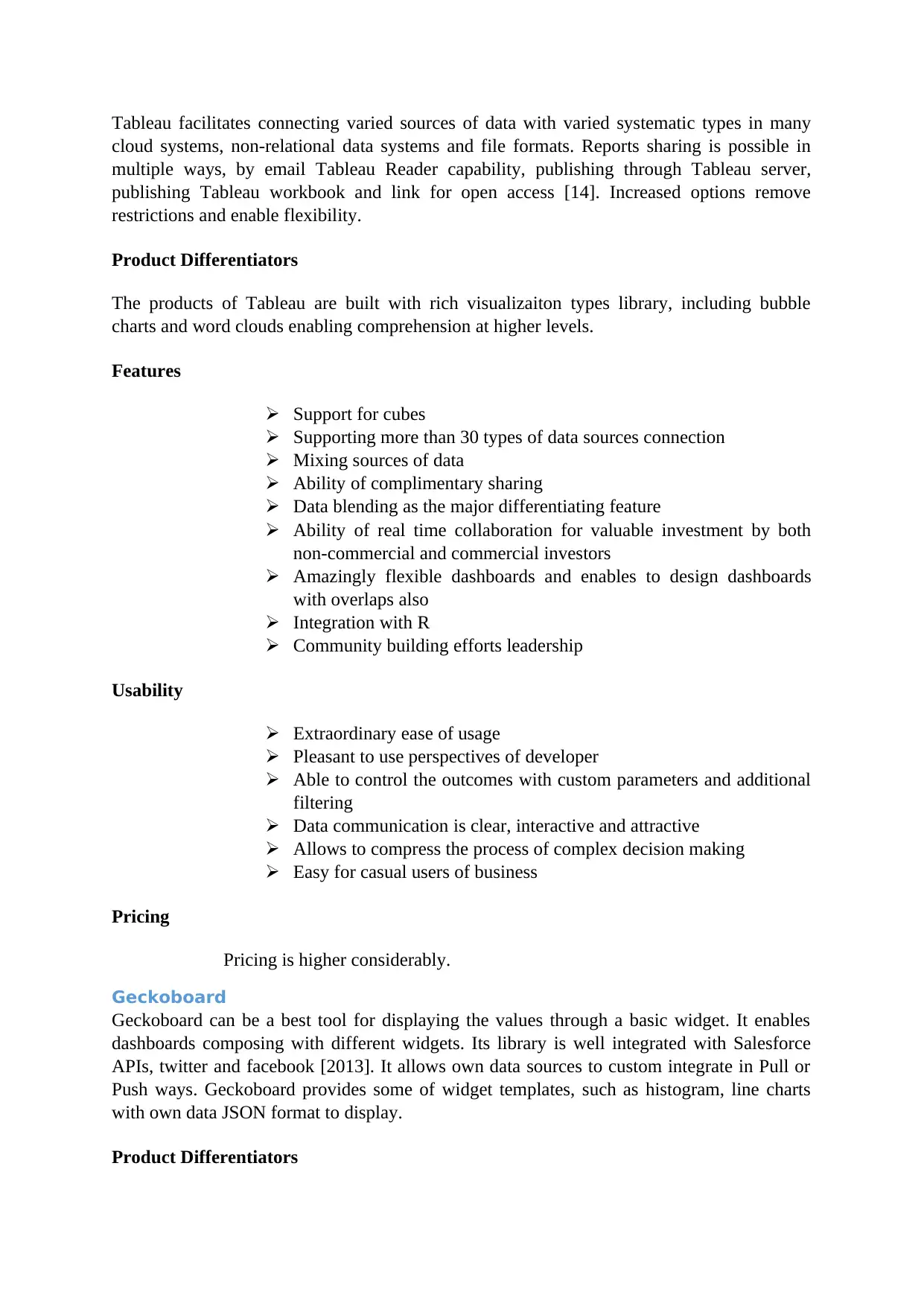
Tableau facilitates connecting varied sources of data with varied systematic types in many
cloud systems, non-relational data systems and file formats. Reports sharing is possible in
multiple ways, by email Tableau Reader capability, publishing through Tableau server,
publishing Tableau workbook and link for open access [14]. Increased options remove
restrictions and enable flexibility.
Product Differentiators
The products of Tableau are built with rich visualizaiton types library, including bubble
charts and word clouds enabling comprehension at higher levels.
Features
Support for cubes
Supporting more than 30 types of data sources connection
Mixing sources of data
Ability of complimentary sharing
Data blending as the major differentiating feature
Ability of real time collaboration for valuable investment by both
non-commercial and commercial investors
Amazingly flexible dashboards and enables to design dashboards
with overlaps also
Integration with R
Community building efforts leadership
Usability
Extraordinary ease of usage
Pleasant to use perspectives of developer
Able to control the outcomes with custom parameters and additional
filtering
Data communication is clear, interactive and attractive
Allows to compress the process of complex decision making
Easy for casual users of business
Pricing
Pricing is higher considerably.
Geckoboard
Geckoboard can be a best tool for displaying the values through a basic widget. It enables
dashboards composing with different widgets. Its library is well integrated with Salesforce
APIs, twitter and facebook [2013]. It allows own data sources to custom integrate in Pull or
Push ways. Geckoboard provides some of widget templates, such as histogram, line charts
with own data JSON format to display.
Product Differentiators
cloud systems, non-relational data systems and file formats. Reports sharing is possible in
multiple ways, by email Tableau Reader capability, publishing through Tableau server,
publishing Tableau workbook and link for open access [14]. Increased options remove
restrictions and enable flexibility.
Product Differentiators
The products of Tableau are built with rich visualizaiton types library, including bubble
charts and word clouds enabling comprehension at higher levels.
Features
Support for cubes
Supporting more than 30 types of data sources connection
Mixing sources of data
Ability of complimentary sharing
Data blending as the major differentiating feature
Ability of real time collaboration for valuable investment by both
non-commercial and commercial investors
Amazingly flexible dashboards and enables to design dashboards
with overlaps also
Integration with R
Community building efforts leadership
Usability
Extraordinary ease of usage
Pleasant to use perspectives of developer
Able to control the outcomes with custom parameters and additional
filtering
Data communication is clear, interactive and attractive
Allows to compress the process of complex decision making
Easy for casual users of business
Pricing
Pricing is higher considerably.
Geckoboard
Geckoboard can be a best tool for displaying the values through a basic widget. It enables
dashboards composing with different widgets. Its library is well integrated with Salesforce
APIs, twitter and facebook [2013]. It allows own data sources to custom integrate in Pull or
Push ways. Geckoboard provides some of widget templates, such as histogram, line charts
with own data JSON format to display.
Product Differentiators
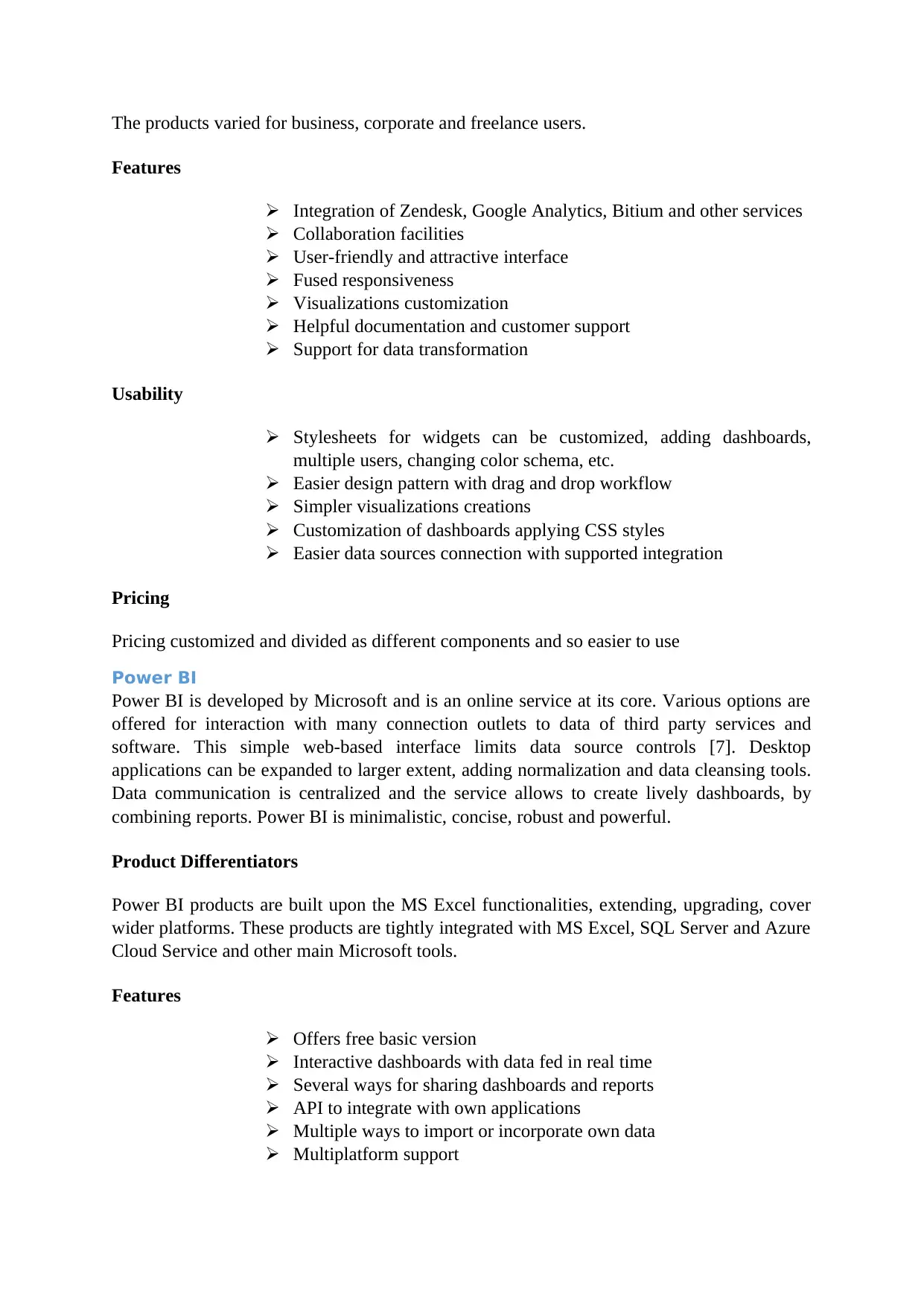
The products varied for business, corporate and freelance users.
Features
Integration of Zendesk, Google Analytics, Bitium and other services
Collaboration facilities
User-friendly and attractive interface
Fused responsiveness
Visualizations customization
Helpful documentation and customer support
Support for data transformation
Usability
Stylesheets for widgets can be customized, adding dashboards,
multiple users, changing color schema, etc.
Easier design pattern with drag and drop workflow
Simpler visualizations creations
Customization of dashboards applying CSS styles
Easier data sources connection with supported integration
Pricing
Pricing customized and divided as different components and so easier to use
Power BI
Power BI is developed by Microsoft and is an online service at its core. Various options are
offered for interaction with many connection outlets to data of third party services and
software. This simple web-based interface limits data source controls [7]. Desktop
applications can be expanded to larger extent, adding normalization and data cleansing tools.
Data communication is centralized and the service allows to create lively dashboards, by
combining reports. Power BI is minimalistic, concise, robust and powerful.
Product Differentiators
Power BI products are built upon the MS Excel functionalities, extending, upgrading, cover
wider platforms. These products are tightly integrated with MS Excel, SQL Server and Azure
Cloud Service and other main Microsoft tools.
Features
Offers free basic version
Interactive dashboards with data fed in real time
Several ways for sharing dashboards and reports
API to integrate with own applications
Multiple ways to import or incorporate own data
Multiplatform support
Features
Integration of Zendesk, Google Analytics, Bitium and other services
Collaboration facilities
User-friendly and attractive interface
Fused responsiveness
Visualizations customization
Helpful documentation and customer support
Support for data transformation
Usability
Stylesheets for widgets can be customized, adding dashboards,
multiple users, changing color schema, etc.
Easier design pattern with drag and drop workflow
Simpler visualizations creations
Customization of dashboards applying CSS styles
Easier data sources connection with supported integration
Pricing
Pricing customized and divided as different components and so easier to use
Power BI
Power BI is developed by Microsoft and is an online service at its core. Various options are
offered for interaction with many connection outlets to data of third party services and
software. This simple web-based interface limits data source controls [7]. Desktop
applications can be expanded to larger extent, adding normalization and data cleansing tools.
Data communication is centralized and the service allows to create lively dashboards, by
combining reports. Power BI is minimalistic, concise, robust and powerful.
Product Differentiators
Power BI products are built upon the MS Excel functionalities, extending, upgrading, cover
wider platforms. These products are tightly integrated with MS Excel, SQL Server and Azure
Cloud Service and other main Microsoft tools.
Features
Offers free basic version
Interactive dashboards with data fed in real time
Several ways for sharing dashboards and reports
API to integrate with own applications
Multiple ways to import or incorporate own data
Multiplatform support
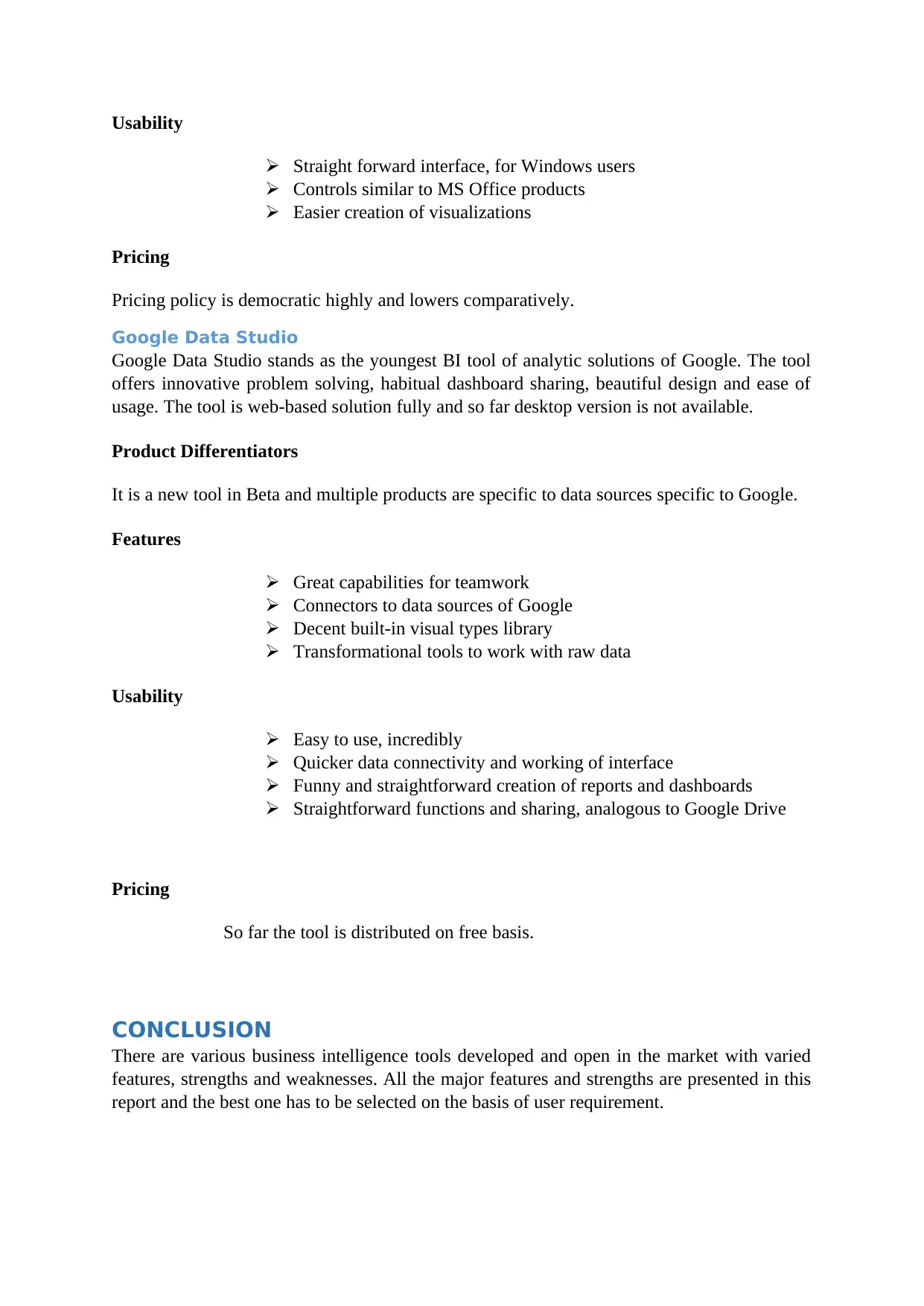
Usability
Straight forward interface, for Windows users
Controls similar to MS Office products
Easier creation of visualizations
Pricing
Pricing policy is democratic highly and lowers comparatively.
Google Data Studio
Google Data Studio stands as the youngest BI tool of analytic solutions of Google. The tool
offers innovative problem solving, habitual dashboard sharing, beautiful design and ease of
usage. The tool is web-based solution fully and so far desktop version is not available.
Product Differentiators
It is a new tool in Beta and multiple products are specific to data sources specific to Google.
Features
Great capabilities for teamwork
Connectors to data sources of Google
Decent built-in visual types library
Transformational tools to work with raw data
Usability
Easy to use, incredibly
Quicker data connectivity and working of interface
Funny and straightforward creation of reports and dashboards
Straightforward functions and sharing, analogous to Google Drive
Pricing
So far the tool is distributed on free basis.
CONCLUSION
There are various business intelligence tools developed and open in the market with varied
features, strengths and weaknesses. All the major features and strengths are presented in this
report and the best one has to be selected on the basis of user requirement.
Straight forward interface, for Windows users
Controls similar to MS Office products
Easier creation of visualizations
Pricing
Pricing policy is democratic highly and lowers comparatively.
Google Data Studio
Google Data Studio stands as the youngest BI tool of analytic solutions of Google. The tool
offers innovative problem solving, habitual dashboard sharing, beautiful design and ease of
usage. The tool is web-based solution fully and so far desktop version is not available.
Product Differentiators
It is a new tool in Beta and multiple products are specific to data sources specific to Google.
Features
Great capabilities for teamwork
Connectors to data sources of Google
Decent built-in visual types library
Transformational tools to work with raw data
Usability
Easy to use, incredibly
Quicker data connectivity and working of interface
Funny and straightforward creation of reports and dashboards
Straightforward functions and sharing, analogous to Google Drive
Pricing
So far the tool is distributed on free basis.
CONCLUSION
There are various business intelligence tools developed and open in the market with varied
features, strengths and weaknesses. All the major features and strengths are presented in this
report and the best one has to be selected on the basis of user requirement.
Paraphrase This Document
Need a fresh take? Get an instant paraphrase of this document with our AI Paraphraser
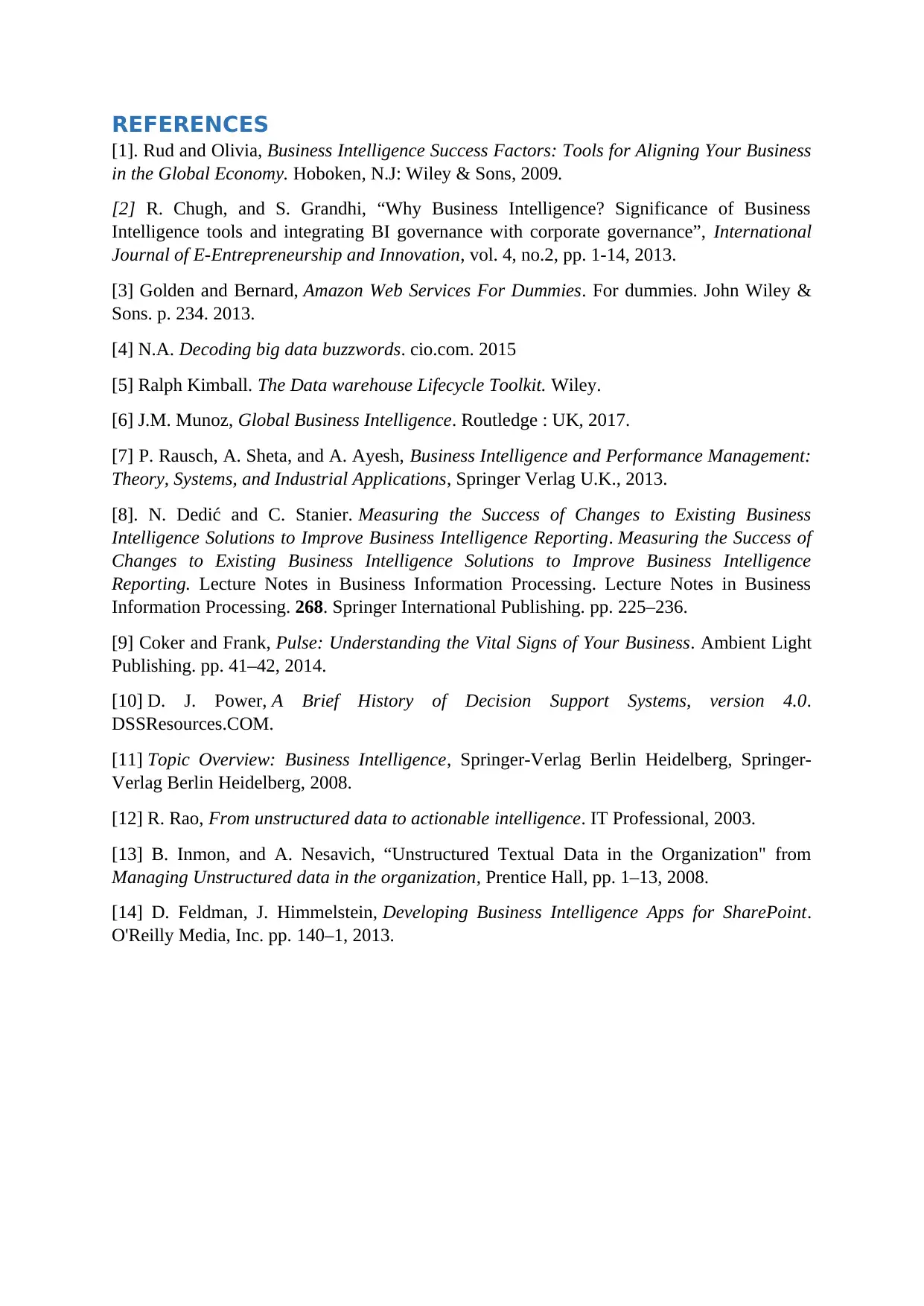
REFERENCES
[1]. Rud and Olivia, Business Intelligence Success Factors: Tools for Aligning Your Business
in the Global Economy. Hoboken, N.J: Wiley & Sons, 2009.
[2] R. Chugh, and S. Grandhi, “Why Business Intelligence? Significance of Business
Intelligence tools and integrating BI governance with corporate governance”, International
Journal of E-Entrepreneurship and Innovation, vol. 4, no.2, pp. 1-14, 2013.
[3] Golden and Bernard, Amazon Web Services For Dummies. For dummies. John Wiley &
Sons. p. 234. 2013.
[4] N.A. Decoding big data buzzwords. cio.com. 2015
[5] Ralph Kimball. The Data warehouse Lifecycle Toolkit. Wiley.
[6] J.M. Munoz, Global Business Intelligence. Routledge : UK, 2017.
[7] P. Rausch, A. Sheta, and A. Ayesh, Business Intelligence and Performance Management:
Theory, Systems, and Industrial Applications, Springer Verlag U.K., 2013.
[8]. N. Dedić and C. Stanier. Measuring the Success of Changes to Existing Business
Intelligence Solutions to Improve Business Intelligence Reporting. Measuring the Success of
Changes to Existing Business Intelligence Solutions to Improve Business Intelligence
Reporting. Lecture Notes in Business Information Processing. Lecture Notes in Business
Information Processing. 268. Springer International Publishing. pp. 225–236.
[9] Coker and Frank, Pulse: Understanding the Vital Signs of Your Business. Ambient Light
Publishing. pp. 41–42, 2014.
[10] D. J. Power, A Brief History of Decision Support Systems, version 4.0.
DSSResources.COM.
[11] Topic Overview: Business Intelligence, Springer-Verlag Berlin Heidelberg, Springer-
Verlag Berlin Heidelberg, 2008.
[12] R. Rao, From unstructured data to actionable intelligence. IT Professional, 2003.
[13] B. Inmon, and A. Nesavich, “Unstructured Textual Data in the Organization" from
Managing Unstructured data in the organization, Prentice Hall, pp. 1–13, 2008.
[14] D. Feldman, J. Himmelstein, Developing Business Intelligence Apps for SharePoint.
O'Reilly Media, Inc. pp. 140–1, 2013.
[1]. Rud and Olivia, Business Intelligence Success Factors: Tools for Aligning Your Business
in the Global Economy. Hoboken, N.J: Wiley & Sons, 2009.
[2] R. Chugh, and S. Grandhi, “Why Business Intelligence? Significance of Business
Intelligence tools and integrating BI governance with corporate governance”, International
Journal of E-Entrepreneurship and Innovation, vol. 4, no.2, pp. 1-14, 2013.
[3] Golden and Bernard, Amazon Web Services For Dummies. For dummies. John Wiley &
Sons. p. 234. 2013.
[4] N.A. Decoding big data buzzwords. cio.com. 2015
[5] Ralph Kimball. The Data warehouse Lifecycle Toolkit. Wiley.
[6] J.M. Munoz, Global Business Intelligence. Routledge : UK, 2017.
[7] P. Rausch, A. Sheta, and A. Ayesh, Business Intelligence and Performance Management:
Theory, Systems, and Industrial Applications, Springer Verlag U.K., 2013.
[8]. N. Dedić and C. Stanier. Measuring the Success of Changes to Existing Business
Intelligence Solutions to Improve Business Intelligence Reporting. Measuring the Success of
Changes to Existing Business Intelligence Solutions to Improve Business Intelligence
Reporting. Lecture Notes in Business Information Processing. Lecture Notes in Business
Information Processing. 268. Springer International Publishing. pp. 225–236.
[9] Coker and Frank, Pulse: Understanding the Vital Signs of Your Business. Ambient Light
Publishing. pp. 41–42, 2014.
[10] D. J. Power, A Brief History of Decision Support Systems, version 4.0.
DSSResources.COM.
[11] Topic Overview: Business Intelligence, Springer-Verlag Berlin Heidelberg, Springer-
Verlag Berlin Heidelberg, 2008.
[12] R. Rao, From unstructured data to actionable intelligence. IT Professional, 2003.
[13] B. Inmon, and A. Nesavich, “Unstructured Textual Data in the Organization" from
Managing Unstructured data in the organization, Prentice Hall, pp. 1–13, 2008.
[14] D. Feldman, J. Himmelstein, Developing Business Intelligence Apps for SharePoint.
O'Reilly Media, Inc. pp. 140–1, 2013.
1 out of 8
Your All-in-One AI-Powered Toolkit for Academic Success.
+13062052269
info@desklib.com
Available 24*7 on WhatsApp / Email
![[object Object]](/_next/static/media/star-bottom.7253800d.svg)
Unlock your academic potential
© 2024 | Zucol Services PVT LTD | All rights reserved.


